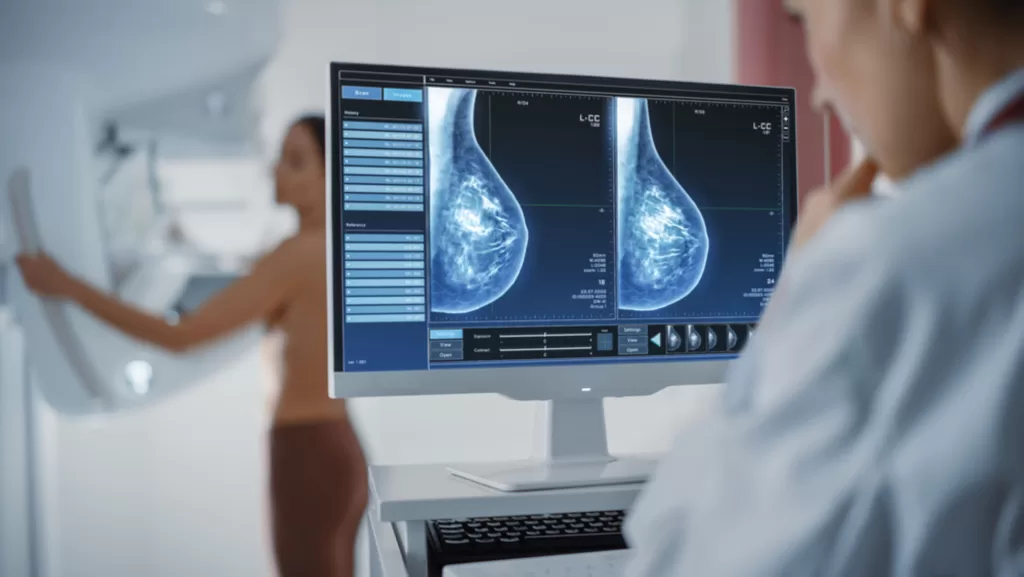TNBC: Understanding Its Silent Progression and Disproportionate Impact on Black Women
In the ongoing battle against breast cancer, attention is increasingly being drawn to Triple-Negative Breast Cancer (TNBC). This aggressive subtype affects women of African descent1, with Black women more than twice as likely as White women to receive a diagnosis of TNBC2.
Breast cancer comes in different forms, each requiring a unique treatment approach. Most breast cancers are categorised by the presence of three common markers: oestrogen receptor (called ER-positive), progesterone receptor (PR-positive), and human epidermal growth factor receptor 2 (HER2-positive)3.
A diagnosis of triple-negative breast cancer means that the three most common types of receptors known to fuel most breast cancer growth–oestrogen, progesterone, and the HER-2/neu gene– are not present in the cancer tumour. This means that the breast cancer cells have tested negative for the hormone epidermal growth factor receptor 2 (HER-2), oestrogen receptors (ER), and progesterone receptors (PR)4.
Breast cancer cells may have one, both, or none of these receptors5.
● ER-positive: Breast cancers that have oestrogen receptors are called ER-positive (or ER+) cancers.
● PR-positive: Breast cancers with progesterone receptors are called PR-positive (or PR+) cancers.
● Hormone receptor-positive: If the cancer cell has one or both of the receptors above, the term hormone-receptive positive (also called hormone-positive or HR+) breast cancer may be used.
● Hormone receptor-negative: If the cancer cell does not have the oestrogen or the progesterone receptor, it’s called hormone-receptor negative (also called hormone-negative or HR-).
Keeping the hormones oestrogen and progesterone from attaching to the receptors can help keep the cancer from growing and spreading5.
Triple-negative breast cancer is a kind of breast cancer that does not have any of the receptors that are commonly found in breast cancer, hence the name ‘triple-negative’. 6
This absence makes TNBC extremely difficult to treat 7 while presenting a number of challenges, namely:
Treatment Resistance: Because TNBC doesn’t have ER, PR, and HER2 receptors, treatments like hormone therapy and drugs targeting HER2 are not helpful.8 A multidisciplinary strategy involving surgery, chemotherapy, radiation therapy and immunotherapy yields better survival.9
Aggressiveness: TNBC tends to grow quickly,10 is more likely to have spread at the time it’s found, is more likely to come back early after treatment than other types of breast cancer and is more likely to metastasise.
Disproportionate Impact: TNBC disproportionately affects Black women and contributes to racial disparities in breast cancer mortality. While the exact reasons for this disparity are still under investigation, researchers say that there are many possible causes of this variation in prevalence among Black women, and possible factors include genetics, health behaviours, social structures and income.11
Sheldene’s Journey: A Tale of Strength
Consider the journey of Sheldene Masondo, a 42-year-old woman and mother of three. A housecleaning accident which involved her daughter bumping into her breast led to the mother of three obtaining a relatively early diagnosis of aggressive triple-negative breast cancer (TNBC), launching her into a whirlwind of treatments and emotional battles. For women like her, the journey begins with understanding the risk factors and the significant role genes play in this silent but formidable cancer type. Sheldene is a member of the cancer advocacy group Cancervive.
The Role of Genes
The involvement of genes, particularly BRCA1 and BRCA2 mutations, plays a significant role in the development and aggression of TNBC. People with BReast CAncer (BRCA) gene mutations have a significantly higher lifetime risk of developing breast cancer than the rest of the population. There are two types of BRCA genes: BRCA1 and BRCA2. People who have a genetic mutation in one of these genes have an increased risk of receiving a breast cancer diagnosis.11
Those with the BRCA1 gene mutation are more likely to have triple-negative breast cancer (TNBC).11
Genetic testing for BRCA1 and BRCA2 mutations is vital for those with a family history of breast or ovarian cancer because it aids in early detection and prevention. Recognising these mutations allows for personalised preventive measures, including frequent screenings, preventive surgeries, or risk-reducing medications. 12
Overcoming misconceptions
Low- and middle-income countries (LMICs) contribute approximately 70% of global cancer deaths, and cancer incidence in these countries is rapidly increasing. Sub-Saharan African (SSA) countries, including South Africa (SA), bear some of the world’s highest cancer case fatality rates, largely attributed to late diagnosis.13
South Africa’s diverse cultural landscape shapes perceptions of cancer, sometimes fostering myths, such as the view of cancer as a disease affecting primarily white populations. These beliefs, while deep-rooted, open avenues for robust educational initiatives.
With respect to traditional viewpoints, including those that attribute cancer to supernatural forces, public education campaigns to increase knowledge and decrease stigma are crucial in promoting the prevention and treatment of cancer in South Africa. Implementing interventions in culturally sensitive ways can enhance the reach of educational messages and increase adherence to treatment.14
Diagnosis and Treatment Focus
Early detection of TNBC is critical because it is more treatable in the early stages of the disease. This process involves mammograms, biopsies, and genetic testing for those at risk. When TNBC is detected early, it is more likely to be confined to the breast tissue, making it easier to treat with surgery, radiation therapy, and chemotherapy.15
Understanding the symptoms, which include a new lump or mass, swelling in all or any part of the breast, dimpled skin or swollen lymph nodes, and risks for triple-negative breast cancer, helps in better diagnosis and treatment of cancer.
Once diagnosed, treatment plans are outlined on the basis of the cancer stage and the patient’s overall health.15
Innovative Therapies that Change the Game
In the realm of TNBC treatment, there are various treatments available such as surgery, radiation therapy, chemotherapy, and immunotherapy9. New therapies are continually emerging, providing alternative options for those with TNBC; one such development is Immunotherapy, an innovative treatment that works to help treat cancer.16
Different types of immunotherapy work in different ways. Some immunotherapy treatments help the immune system stop or slow the growth of cancer cells. Others help the immune system destroy cancer cells or stop the cancer from spreading to other parts of the body.17
Commenting on immunotherapy, South African Breast Cancer Specialist Oncologist Dr Irene Boeddinghaus says for the first time in a century of treating TNBC, we’ve found a way to use the body’s own immune system to kill off the most aggressive and treatment-resistant of these diseases.
She said that the addition of immunotherapy to chemotherapy prior to surgery in TNBC, increased the chances of the cancer disappearing entirely by the time of surgery by 14%. This translates directly into an overall survival benefit for patients.

References:
1.TNBC in women of African descent: https://pubmed.ncbi.nlm.nih.gov/35851365/#:~:text=Statistical%20analysis%20was%20performed.,(mean%20age%2064%20years) –published June 2022. Accessed on 11 October 2023
2.Black women more than twice as likely as White women: https://www.medicalnewstoday.com/articles/what-women-of-color-should-know-about-triple-negative-breast-cancer#:~:text=in%20more%20detail.-,Black%20women%20and%20TNBC,on%20where%20they%20were%20born Accessed: 11 October 2023
3.Explaining TNBC: https://www.bcrf.org/blog/triple-negative-breast-cancer-treatment-symptoms-research/ Accessed: 11 October 2023
4.Diagnosis: https://www.nationalbreastcancer.org/triple-negative-breast-cancer/ Accessed 10 October 2023
5.About TNBC: https://www.cdc.gov/cancer/breast/triple-negative.htm Accessed 10 October 2023
6.Treatment options: https://www.ncbi.nlm.nih.gov/pmc/articles/PMC10384267/ Accessed 10 October 2023
7.Treatment of Triple-negative Breast Cancer: https://www.cancer.org/cancer/types/breast-cancer/treatment/treatment-of-triple-negative.html#:~:text=Triple%2Dnegative%20breast%20cancer%20(TNBC,the%20main%20systemic%20treatment%20option. Accessed 10 October 2023
8.Treatments for triple-negative breast cancer: https://www.breastcancer.org/types/triple-negative. Accessed 11 October 2023
9.Survival rates for triple-negative breast cancer: https://www.cancer.org/cancer/types/breast-cancer/about/types-of-breast-cancer/triple-negative.html#:~:text=TNBC%20tends%20to%20grow%20quickly,other%20types%20of%20breast%20cancer Accessed 11 October 2023
10.Racial disparities in triple-negative breast cancer: toward a causal architecture approach: https://breast-cancer-research.biomedcentral.com/articles/10.1186/s13058-022-01533-z Accessed 10 October 2023
11.Triple-negative breast cancer and BRCA1 mutation: What is the link? https://www.medicalnewstoday.com/articles/triple-negative-breast-cancer-and-brca1-mutation#:~:text=People%20who%20have%20a%20genetic,aggressive%20form%20of%20breast%20cancer. Accessed 10 October 2023
12.Hereditary Breast and Ovarian Cancer: https://www.cancer.net/cancer-types/hereditary-breast-and-ovarian-cancer#:~:text=Most%20breast%20and%20ovarian%20cancers%20occur%20by%20chance%20with%20no,family%20history%20that%20suggests%20HBOC.Accessed 10 October 2023
13.A qualitative study to explore healthcare providers’ perspectives on barriers and enablers to early detection of breast and cervical cancers among women attending primary healthcare clinics in Johannesburg, South Africa: https://www.ncbi.nlm.nih.gov/pmc/articles/PMC10168575/ Accessed 11 October 2023
14.Understanding stigma as a barrier to accessing cancer treatment in South Africa: implications for public health campaigns: https://www.ncbi.nlm.nih.gov/pmc/articles/PMC5987085/ Accessed 11 October 2023
15.The Importance of Early Detection for Triple Negative Breast Cancer: https://nybreasthealth.com/news/the-importance-of-early-detection-for-triple-negative-breast-cancer#:~:text=Early%20detection%20of%20TNBC%20is,%2C%20radiation%20therapy%2C%20and%20chemotherapy. Accessed 11 October 2023
16.With immunotherapy treatment, healing starts from within: https://www.adventhealthcancerinstitute.com/cancer-treatment-innovations/immunotherapy Accessed 13 October
17.What is immunotherapy: https://www.cancer.net/navigating-cancer-care/how-cancer-treated/immunotherapy-and-vaccines/what-immunotherapy Accessed 11 October 2023






























